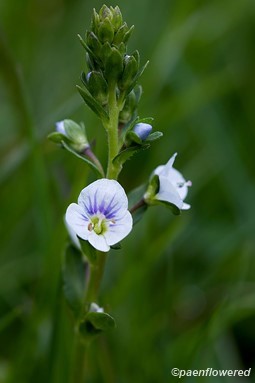Veronica serpyllifolia
A European speedwell with tiny, inconspicuous flowers
Veronica serpyllifolia thyme-leaved speedwell
This small perennial plant is in the plantain family. Although the flowers are quite pretty if you get close enough, they are so small that they are often ignored unless they become a yard invasive. It has a worldwide distribution and the USDA considers it both native and introduced in the United States, though other sources say it was introduced from Europe. It is found throughout Pennsylvania.
The leaves are oval in shape arising from green thin creeping stems. They are ¼ to ¾ inches long. The stems are lightly hairy. The roots grow from the axils of the leaves. The flowering stems or racemes are upright, and bear flowers that are blue or white with purple or blue stripes. The lower of the four petals is smaller than the rest and often lighter in color. The flowers are about ¼ inch in diameter and produced individually or in pairs on the vertical stem. The flower petiole is ¼ inch long. It produces nectar for small pollinating insects. The fruit is a 2-part pod that carries tiny seeds. The seeds are flat and can cling to fur, feathers or even shoes.
The plant can grow 4-12 inches tall, smaller where it is periodically mowed. They do well in sun or part shade with moist to moderately wet soils. Most growth occurs in the spring when the weather is cool and rainy. It is moderately toxic but rabbits, groundhogs and geese seem to eat the leaves.
The native purslane speedwell (P. peregrina) is similar, but the flowers are whiter and the stems are hairless. The flowers of the purslane speedwell also are found in the axils of branching vertical stems.
Habitat & Range
Grows in lawns, meadows, fields, and open woods.
Present throughout the state.
| EMP: | FAC |
|---|---|
| NCNE: | FAC |
Phenology
Flowers May through August.











.jpg?v=637828013470000000)




Comments
Have you spotted this plant in your area? We'd love to hear about your experience! Share your comments or questions about the plant below. Comments are moderated before posting.